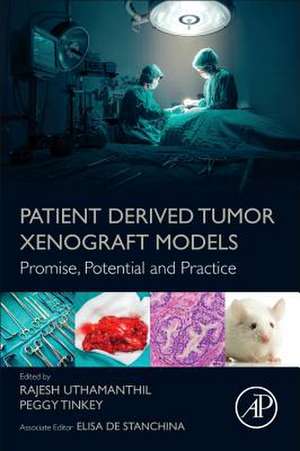Patient Derived Tumor Xenograft Models: Promise, Potential and Practice
Editat de Rajesh Uthamanthil, Peggy Tinkey, Elisa de Stanchinaen Limba Engleză Paperback – noi 2016
In addition, proper methodologies suitable for growing different type of tumors, acquisition of pathology, genomic and other data about the tumor, potential pitfalls, and confounding background pathologies that occur in these models are also included, as is a discussion of the facilities and infrastructure required to operate a PDX laboratory.
- Offers guidance on data interpretation and regulatory aspects
- Provides useful techniques and strategies for working with PDX models
- Includes practical tools and potential pitfalls for best practices
- Compiles all knowledge of PDX models research in one resource
- Presents the results of first ever global survey on standards of PDX development and usage in academia and industry
Preț: 676.84 lei
Preț vechi: 854.84 lei
-21% Nou
Puncte Express: 1015
Preț estimativ în valută:
129.51€ • 135.58$ • 107.16£
129.51€ • 135.58$ • 107.16£
Carte tipărită la comandă
Livrare economică 31 martie-14 aprilie
Preluare comenzi: 021 569.72.76
Specificații
ISBN-13: 9780128040102
ISBN-10: 0128040106
Pagini: 486
Dimensiuni: 152 x 229 x 28 mm
Greutate: 0.82 kg
Editura: ELSEVIER SCIENCE
ISBN-10: 0128040106
Pagini: 486
Dimensiuni: 152 x 229 x 28 mm
Greutate: 0.82 kg
Editura: ELSEVIER SCIENCE
Cuprins
Section I. Mouse Xenograft Models of Cancer
Chapter 1. PDX Models: History and Development
Chapter 2. History of Mouse Cancer Models
Chapter 3. Challenges and Limitations of Mouse Xenograft Models of Cancer
Chapter 4. Tumor Heterogeneity
Chapter 5. Immunodeficient Mice: The Backbone of Patient-Derived Tumor Xenograft Models
Chapter 6. Humanized Mice and PDX Models
Section II. Components of a PDX Program
Chapter 1. Regulations of Patient-Derived Xenografts
Chapter 2. Acquisition and Storage of Clinical Samples to Establish PDX Models
Chapter 3. Methodologies for Developing and Maintaining Patient-Derived Xenograft Mouse Models
Chapter 4. Pathology of Patient-Derived Xenograft Tumors
Chapter 5. Genetic Profiling of Tumors in PDX Models
Chapter 6. Running a PDX Core Laboratory or a PDX Support Program
Chapter 7. Veterinary Care
Chapter 8. Occupational Health and Safety
Section III. PDX Models for Tumors of Various Organ Systems
Chapter 1. Pediatric and Adult Brain Tumor PDX Models
Chapter 2. Patient-Derived Xenograft Models of Prostate Tumors
Chapter 3. Patient-Derived Xenograft Model of Pancreatic Cancer
Chapter 4. Modeling Breast Cancer Heterogeneity With Patient-Derived Xenografts
Chapter 5. Patient-Derived Xenograft Models of Ovarian/Gynecologic Tumors
Chapter 6. Patient-Derived Xenografts From Lung Cancer and Their Potential Applications
Chapter 7. PDX Models of Colorectal Tumors
Chapter 8. Patient-Derived Tumor Xenografts in Hematologic Disorders
Chapter 9. Patient-Derived Xenografting of Human Melanoma
Chapter 10. Advances in Organoid Culturing of Patient-Derived Tumors
Section IV. PDX Models in Cancer Research and Therapy Around the World
Chapter 1. Global Practices in PDX Programs
Chapter 2. Role of Companies and Corporations in the Development and Utilization of PDX Models
Section V. Challenges & Future of PDX Models
Chapter 1. Patient-Derived Tumor Xenograft: Present and Future Challenges and Applications
Chapter 1. PDX Models: History and Development
Chapter 2. History of Mouse Cancer Models
Chapter 3. Challenges and Limitations of Mouse Xenograft Models of Cancer
Chapter 4. Tumor Heterogeneity
Chapter 5. Immunodeficient Mice: The Backbone of Patient-Derived Tumor Xenograft Models
Chapter 6. Humanized Mice and PDX Models
Section II. Components of a PDX Program
Chapter 1. Regulations of Patient-Derived Xenografts
Chapter 2. Acquisition and Storage of Clinical Samples to Establish PDX Models
Chapter 3. Methodologies for Developing and Maintaining Patient-Derived Xenograft Mouse Models
Chapter 4. Pathology of Patient-Derived Xenograft Tumors
Chapter 5. Genetic Profiling of Tumors in PDX Models
Chapter 6. Running a PDX Core Laboratory or a PDX Support Program
Chapter 7. Veterinary Care
Chapter 8. Occupational Health and Safety
Section III. PDX Models for Tumors of Various Organ Systems
Chapter 1. Pediatric and Adult Brain Tumor PDX Models
Chapter 2. Patient-Derived Xenograft Models of Prostate Tumors
Chapter 3. Patient-Derived Xenograft Model of Pancreatic Cancer
Chapter 4. Modeling Breast Cancer Heterogeneity With Patient-Derived Xenografts
Chapter 5. Patient-Derived Xenograft Models of Ovarian/Gynecologic Tumors
Chapter 6. Patient-Derived Xenografts From Lung Cancer and Their Potential Applications
Chapter 7. PDX Models of Colorectal Tumors
Chapter 8. Patient-Derived Tumor Xenografts in Hematologic Disorders
Chapter 9. Patient-Derived Xenografting of Human Melanoma
Chapter 10. Advances in Organoid Culturing of Patient-Derived Tumors
Section IV. PDX Models in Cancer Research and Therapy Around the World
Chapter 1. Global Practices in PDX Programs
Chapter 2. Role of Companies and Corporations in the Development and Utilization of PDX Models
Section V. Challenges & Future of PDX Models
Chapter 1. Patient-Derived Tumor Xenograft: Present and Future Challenges and Applications









